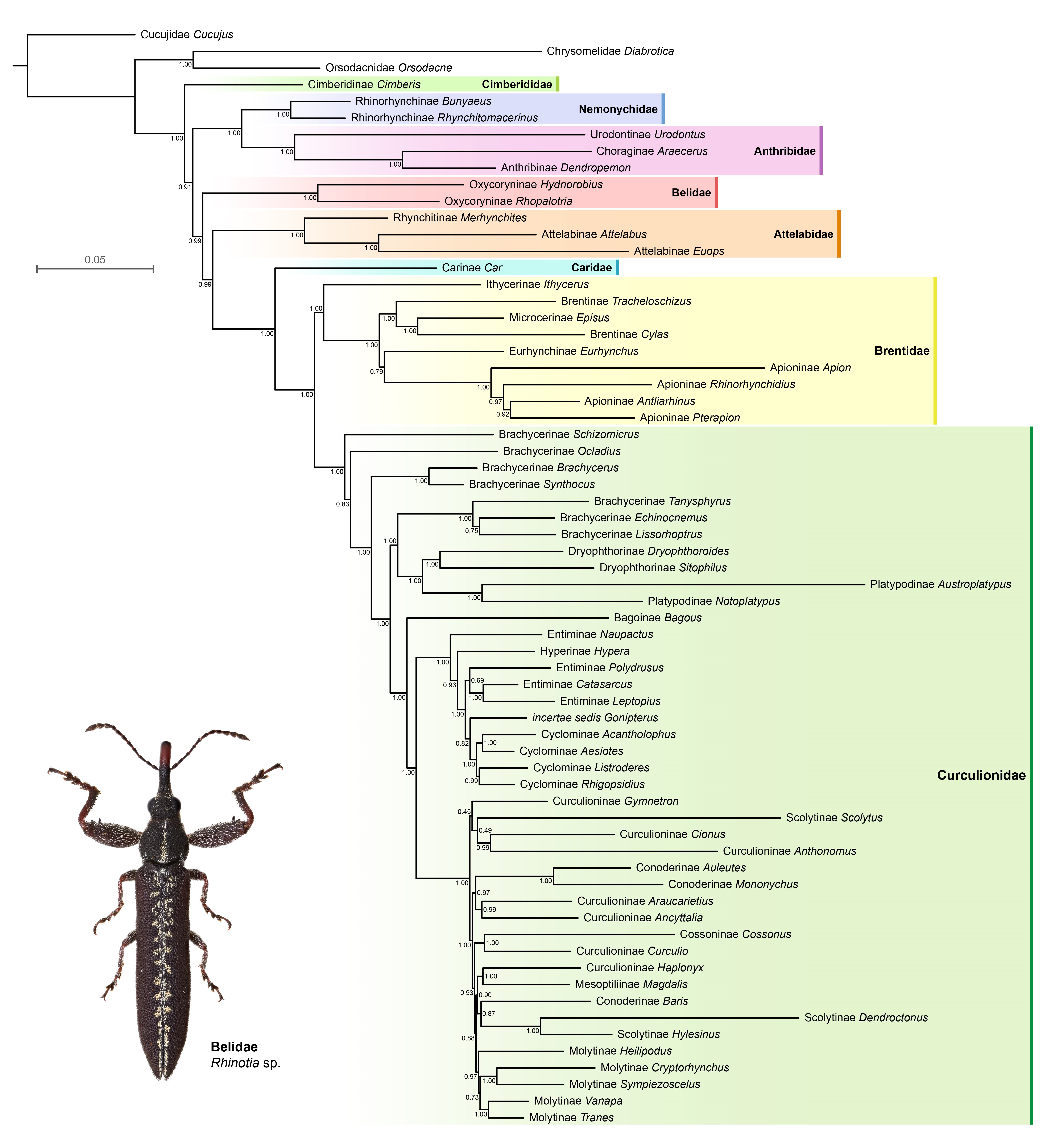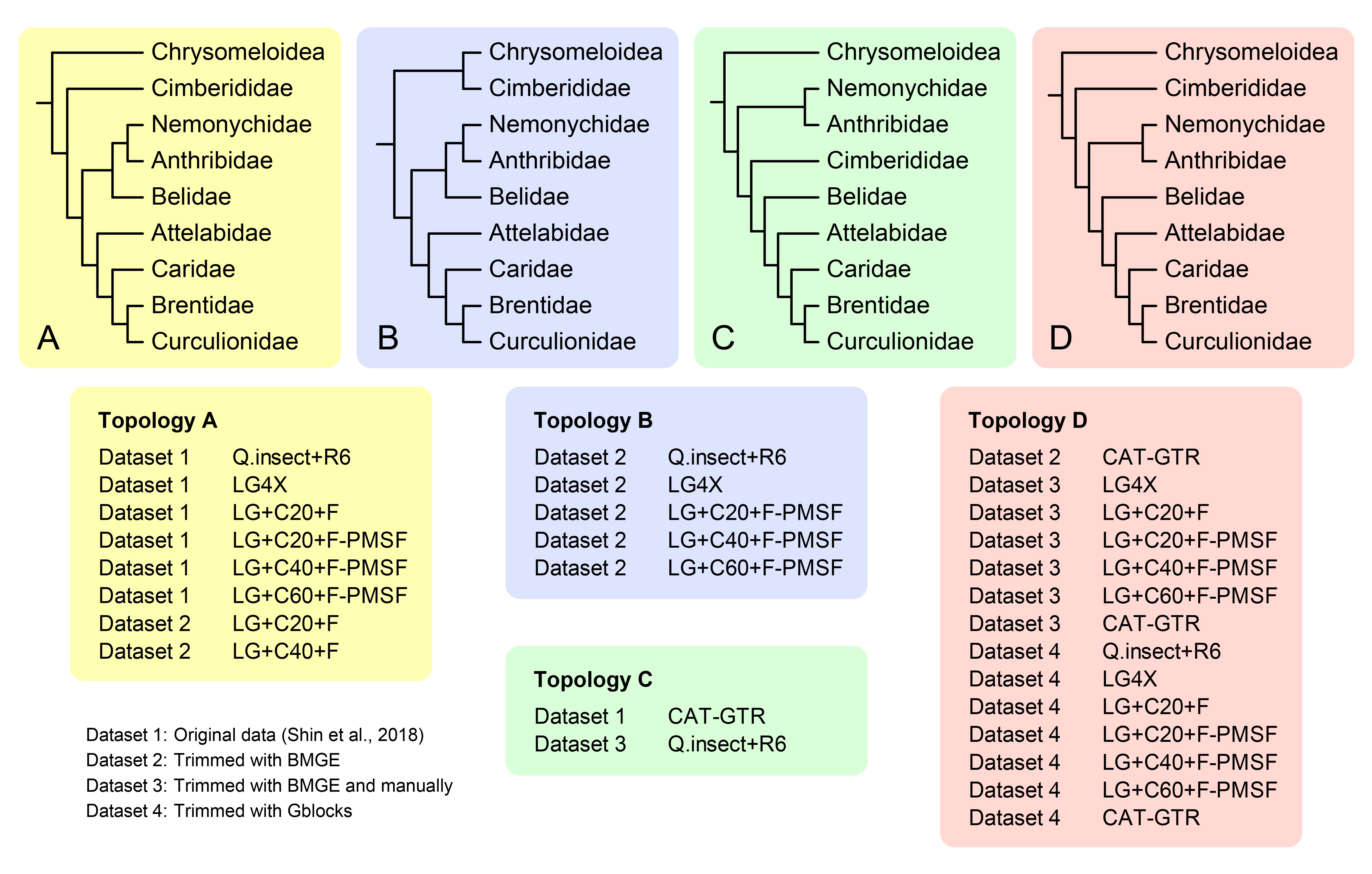Weevils (superfamily Curculionoidea) represent a hyperdiverse and globally distributed group of phytophagous beetles, with approximately 62 000 described species in 5800 genera. Recently, Professor CAI Chenyang from Nanjing Institute of Geology and Palaeontology, Chinese Academy of Sciences (NIGPAS), in collaboration with colleagues, conducted phylogenetic reanalyses of the previously published anchored hybrid enrichment datasets, and solved the evolutionary relationships of extant weevil families.
The result has been recently published in a Royal Society journal Biology Letters.
The vast majority of weevils have a forward-facing rostrum that resembles an elephant's trunk, hence the name weevil. Weevils are divided into eight extant families, i.e. Cimberididae, Nemonychidae, Anthribidae, Belidae, Attelabidae, Caridae, Brentidae and Curculionidae. The evolutionary relationships among the families are largely resolved, with the Attelabidae, Caridae, Brentidae, and Curculionidae constituting a monophyletic group (ACBC clade), while the Cimberididae, Nemonychidae, and Anthribidae are basal lineages. However, the systematic position of Belidae is somewhat controversial, and most studies based on morphological and molecular data generally consider it as the sister group of the ACBC clade.
However, a recent Anchored Hybrid Enrichment (AHE)-based phylogenomic study suggests that Belidae is sister to Nemonychidae and Anthribidae.
In recent years, Prof. CAI's group has devoted itself to the research of molecular phylogenetics and timetree of insects, and used innovative methods in data curation and model selection to construct evolutionary relationships and time frameworks of several key insect lineages. Previously, the team used genome-scale data and site-heterogeneous models to construct a supertree of beetle evolution, and combined with a newly vetted set of fossil calibrations to build a more accurate beetle timetree (Cai et al. 2022). After its publication, it received extensive attention from the academic community, and is now indexed as ESI highly-cited papers and hot papers.
Recently, under the supervision of Prof. Cai, Mr. LI Yanda, a doctoral student at the University of Bristol, in collaboration with colleagues from the American Museum of Natural History and the University of Bristol, compared different data filtering methods, different evolutionary models and different tree building strategies on the tree topology.
Studies have shown that when appropriate data filtering is used to remove incorrectly aligned gene sequences, or when a more appropriate site-heterogeneity evolutionary model is taken, or the coalescent strategy is properly used, Belidae are always resolved as sister groups of the ACBC clade. “This result is fully consistent with the phylogenetic relationship based on morphological evidence”, CAI says, “weprovide a consistent and robust backbone phylogeny of weevils.”
“More important, our analyses emphasize the significance of data curation and modelling compositional heterogeneity of molecular data in today’s phylogenomic studies”, says CAI.
Financial support was provided by the Strategic Priority Research Program of the Chinese Academy of Sciences, the National Natural Science Foundation of China, and the China Scholarship Council.
Reference: Li, Y.-D., Engel, M.S., Tihelka, E. & Cai, C.* (2023) Phylogenomics of weevils revisited: data curation and modelling compositional heterogeneity. Biology Letters, 19, 20230307. https://doi.org/10.1098/rsbl.2023.0307
Cai, C., Tihelka, E., Giacomelli, M., Lawrence, J.F., Slipiński, A., Kundrata, R., Yamamoto, S., Thayer, M.K., Newton, A.F., Leschen, R.A.B., Gimmel, M.L., Lü, L., Engel, M.S., Bouchard, P., Huang, D., Pisani, D. & Donoghue, P.C.J. (2022) Integrated phylogenomics and fossil data illuminate the evolution of beetles. Royal Society Open Science, 9, 211771. (Google Scholar, 115 citations)

Figure 1. Backbone phylogeny of weevils based on AHE amino acid dataset.

Figure 2. Comparison among tree topologies generated with different models and datasets. Topology D is our preferred topology for weevil phylogeny.
Contact:
LIU Yun, Propagandist
Email: yunliu@nigpas.ac.cn
Nanjing Institute of Geology and Palaeontology, Chinese Academy of Sciences
Nanjing, Jiangsu 210008, China
Download:
